Foreword / YouTube Video Review
This pair of speakers was loaned to me by Buchardt along with their Platin Hub.
All my reviews are done on my own time with great care to giving you all the best set of data and information I can provide in order to help you make a well-informed purchase decision. I offer this for free to all who are interested. In return, if you want to support this site please see the bottom of this review for ways you can help. It is greatly appreciated.
A few quick notes about this speaker: it is a powered speaker which features 8 “Mastertunings” options which allow you to choose a specific sound profile available from Buchardt’s website. These range from standard monopole radiation patterns with various timbre profiles to cardioid radiation with timbre options. These are updatable via a simple USB flash drive. Go to Buchardt’s website, pick the “Mastertunings” you want to try, download to USB drive, plug the drive into each speaker’s amplifier and you’re ready to go. The Platin Hub is an optional add-on which allows you to connect various analog/digital sources (RCA, HDMI, Optical, etc) to the hub which then pairs wirelessly to stream the audio to each of the A700 speakers.
The review on this website is a brief overview and summary of the objective performance of this speaker. It is not intended to be a deep dive. Moreso, this is information for those who prefer “just the facts” and prefer to have the data without the filler. The video below has more discussion with respect to the technical merits and subjective notes I had during my listening sessions.
< coming eventually >
Information and Photos
Some specs from the manufacturer can be found here.
The A700 is a pretty compact floorstander. Unlike what you would expect from this size, you have SO much headroom with the total 5 x 6" long stroke woofers. It provides insane deep bass, confidence and power to play loud in even very large rooms. Yet the 3 internal sealed enclosures for the woofers, results in a fast and nuanced bass performance. And with its dedicated midrange, it would hold its sharp image and soundstage at very high SPL levels. They also have the convenience of being wireless if you buy them as a bundle with either the Platin Hub or Primare SC15. Could also be any other WiSA Transmitter. If you, like many people, don’t have the optimal acoustic room, and maybe you don’t have the option to pull speakers far away from the wall, then in this case the A700’s got your back! The sound of the A700 is versatile and subject to change thanks to its unique aspect of multiple Mastertunings. If you feel like it, you have many options to change the sound to your preference or even make them into a Cardioid design. But the overall characteristics of the A700 is a sound that works with your room to create a large and immersive sound. The soundstage is big and deep, and you get this feeling of being wrapped in music with fantastic imaging. It’s a speaker that is easy to listen to for hours without listening fatigue, without having a dark and mellow sound.
- Amplifiers: 4 x 150 RMS / 330 Peak watts class D (each speaker)
- Operating principle: 3.5-way sealed enclosure / 3-way with cardioid back woofers
- Tweeter: 1 x 0,74" Custom fine weave soft fabric textile with CDC aluminum waveguide
- Mid / woofer: 1 x 6" linear long stroke paper cone
- Front / subwoofer: 2 x 6" linear long stroke paper cone
- Rear / subwoofer: 2 x 6" linear long stroke paper cone
- Frequency response: 17 - 40.000 Hz +/- 1.5dB (can change with mastertunings)
- DSP: Quad Core Processor
- DAC chip: 4 x CS4398 (each speaker)
- Crossover point: 100 hz / 250 hz / 2800 hz (can change with mastertunings)
- Cabled analogue input: 24 bit / 192khz ADC / Balanced / Unbalanced XLR / 20k ohms input impedance
- Wireless: WiSA 24 bit / 96khz. Can be paired across brands up to 7.1 setup
- Input voltage: 100-240 Volts AC auto adjusting (EU & US power cords incl.)
- Weight: 60 kg / pair shipping weight
- Measurements (h x w x d): 1000 (1035 with feet) x 180 x 280 mm (39.3” x 7” x 11”)
- Warranty: 5 years on speakers (10 years with registration)
- : 2 years on amp modules (4 years with registration)
- : 2 years on Platin hub / Primare SC15
- Decoupling feet: Included
- Rubber and normal spikes with disk: Included
- Speaker grilles: Included
More information on the Platin Hub (and other options) can be found on the site as well.
As of this writeup, the price per pair is approximately €6000-6200 depending on finish. With the Platin Hub the cost is €6300-6500.
CTA-2034 (SPINORAMA) and Accompanying Data
All data collected using Klippel’s Near-Field Scanner. The Near-Field-Scanner 3D (NFS) offers a fully automated acoustic measurement of direct sound radiated from the source under test. The radiated sound is determined in any desired distance and angle in the 3D space outside the scanning surface. Directivity, sound power, SPL response and many more key figures are obtained for any kind of loudspeaker and audio system in near field applications (e.g. studio monitors, mobile devices) as well as far field applications (e.g. professional audio systems). Utilizing a minimum of measurement points, a comprehensive data set is generated containing the loudspeaker’s high resolution, free field sound radiation in the near and far field. For a detailed explanation of how the NFS works and the science behind it, please watch the below discussion with designer Christian Bellmann:
IMPORTANT SETUP INFO:
The reference plane in this test is between the tweeter and the midwoofer.
The A700 has the ability to load many predefined DSP settings which all result in various sound signatures / output capabilities. You can find more information on the manufacturer’s website. The primary testing for this review was done using the “Neutral (Stock)” setting.
Additional DSP options were configured and tested. They are clearly labeled in the title of each of the SPIN datasets toward the end of this review.
Note that the tested setting is full-range, using DSP to boost the bass which also uses DSP to protect the woofer from mechanical damage should the user try to push the speaker too hard. Therefore, it is reasonable and expected that the distortion and the limiting of this speaker would be relatively high / strict. There are other DSP options that restrict the bass to more typical corner frequencies and thus result in less distortion / limiting at the cost of low frequency output. Tradeoffs.
Got it? Let’s go….
Measurements are provided in a format in accordance with the Standard Method of Measurement for In-Home Loudspeakers (ANSI/CTA-2034-A R-2020). For more information, please see this link.
CTA-2034 / SPINORAMA:
The On-axis Frequency Response (0°) is the universal starting point and in many situations it is a fair representation of the first sound to arrive at a listener’s ears.
The Listening Window is a spatial average of the nine amplitude responses in the ±10º vertical and ±30º horizontal angular range. This encompasses those listeners who sit within a typical home theater audience, as well as those who disregard the normal rules when listening alone.
The Early Reflections curve is an estimate of all single-bounce, first-reflections, in a typical listening room.
Sound Power represents all of the sounds arriving at the listening position after any number of reflections from any direction. It is the weighted rms average of all 70 measurements, with individual measurements weighted according to the portion of the spherical surface that they represent.
Sound Power Directivity Index (SPDI): In this standard the SPDI is defined as the difference between the listening window curve and the sound power curve.
Early Reflections Directivity Index (EPDI): is defined as the difference between the listening window curve and the early reflections curve. In small rooms, early reflections figure prominently in what is measured and heard in the room so this curve may provide insights into potential sound quality.
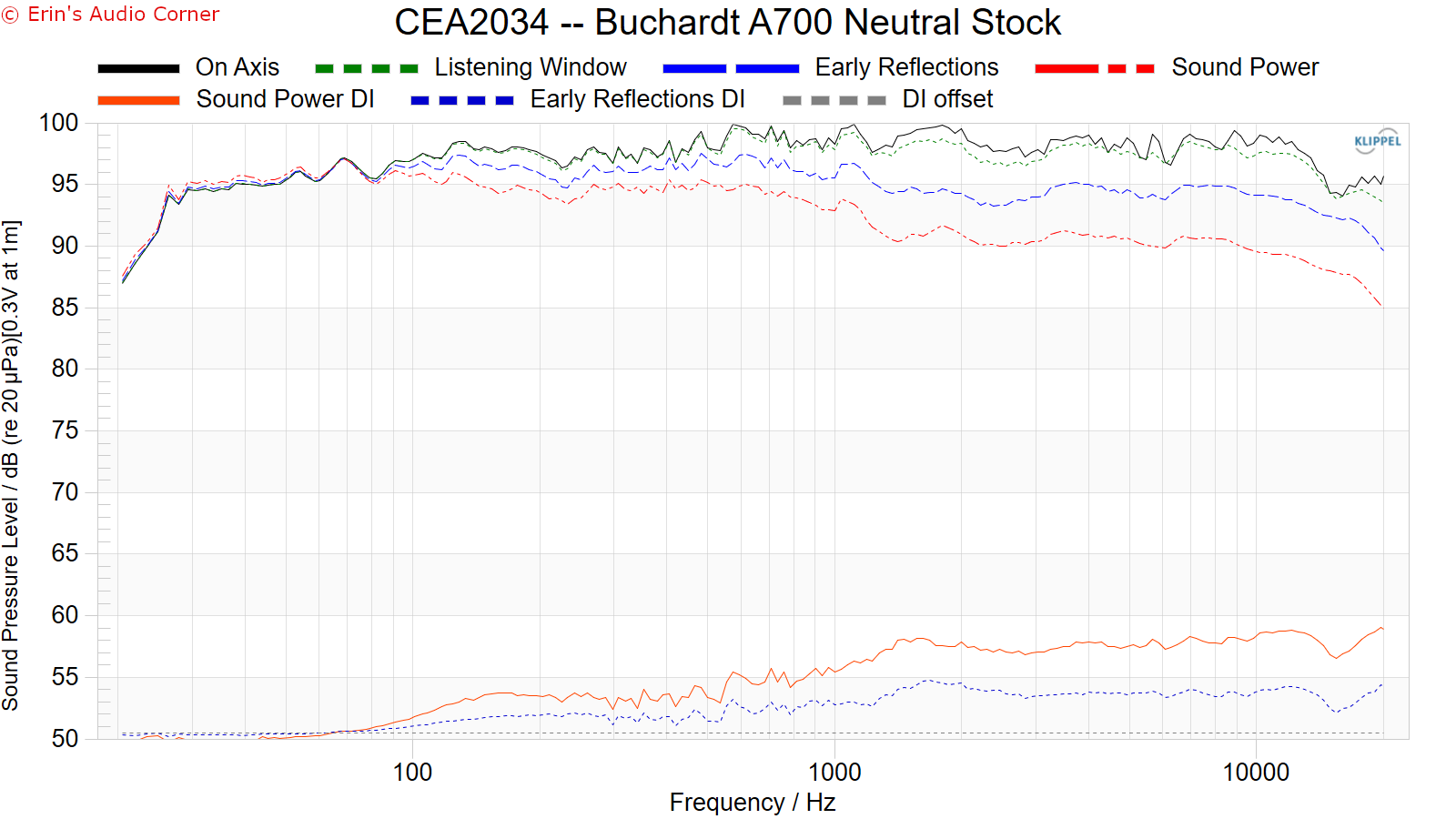
Early Reflections Breakout:
Floor bounce: average of 20º, 30º, 40º down
Ceiling bounce: average of 40º, 50º, 60º up
Front wall bounce: average of 0º, ± 10º, ± 20º, ± 30º horizontal
Side wall bounces: average of ± 40º, ± 50º, ± 60º, ± 70º, ± 80º horizontal
Rear wall bounces: average of 180º, ± 90º horizontal

Estimated In-Room Response:
In theory, with complete 360-degree anechoic data on a loudspeaker and sufficient acoustical and geometrical data on the listening room and its layout it would be possible to estimate with good precision what would be measured by an omnidirectional microphone located in the listening area of that room. By making some simplifying assumptions about the listening space, the data set described above permits a usefully accurate preview of how a given loudspeaker might perform in a typical domestic listening room. Obviously, there are no guarantees, because individual rooms can be acoustically aberrant. Sometimes rooms are excessively reflective (“live”) as happens in certain hot, humid climates, with certain styles of interior décor and in under-furnished rooms. Sometimes rooms are excessively “dead” as in other styles of décor and in some custom home theaters where acoustical treatment has been used excessively. This form of post processing is offered only as an estimate of what might happen in a domestic living space with carpet on the floor and a “normal” amount of seating, drapes and cabinetry.
For these limited circumstances it has been found that a usefully accurate Predicted In-Room (PIR) amplitude response, also known as a “room curve” is obtained by a weighted average consisting of 12 % listening window, 44 % early reflections and 44 % sound power. At very high frequencies errors can creep in because of excessive absorption, microphone directivity, and room geometry. These discrepancies are not considered to be of great importance.

Horizontal Frequency Response (0° to ±90°):

Vertical Frequency Response (0° to ±40°):

Horizontal Contour Plot (normalized):
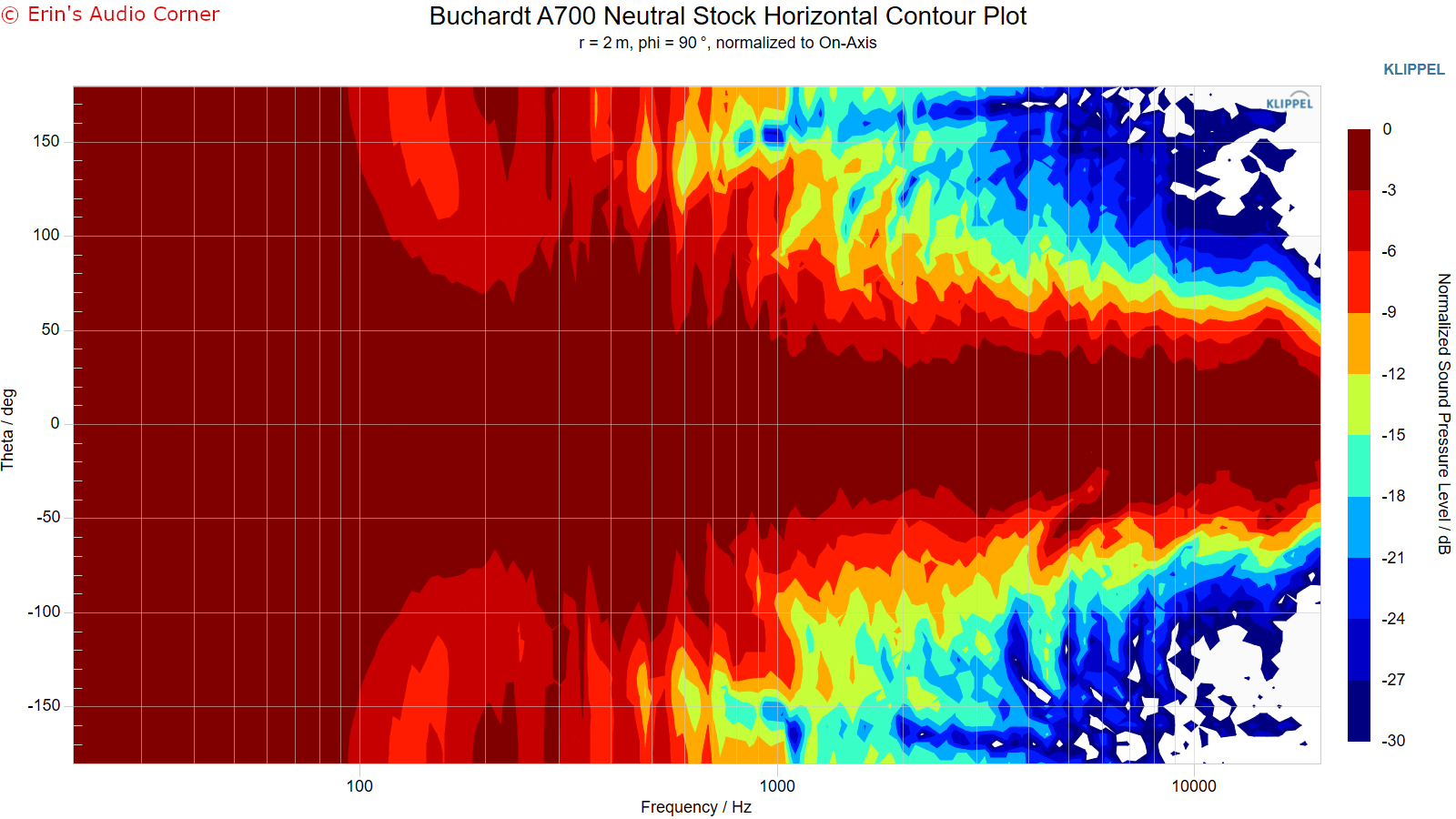
Vertical Contour Plot (normalized):
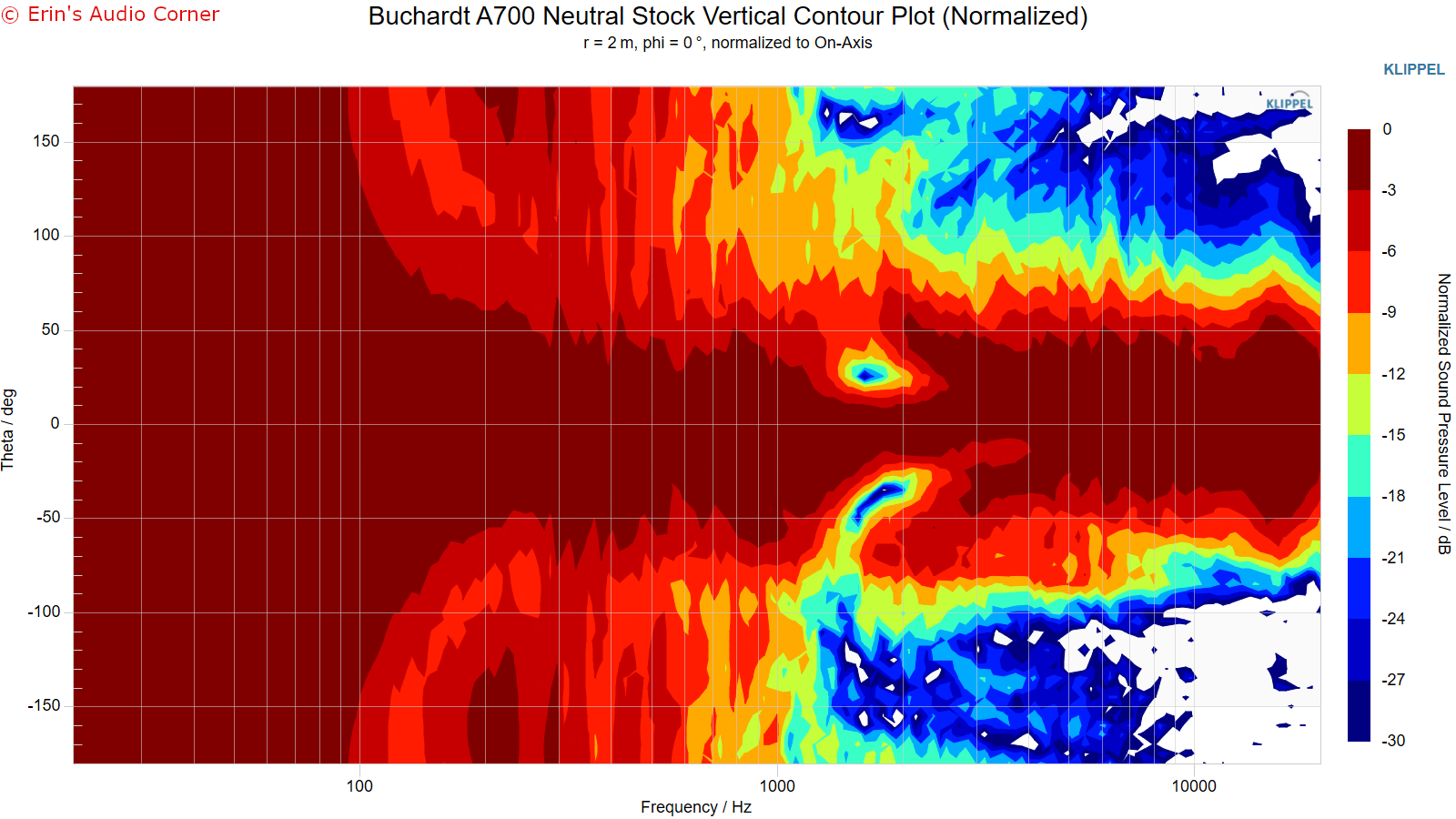
“Globe” Plots
Horizontal Polar (Globe) Plot:
This represents the sound field at 2 meters - above 200Hz - per the legend in the upper left.

Vertical Polar (Globe) Plot:
This represents the sound field at 2 meters - above 200Hz - per the legend in the upper left.

Additional Measurements
Response Linearity
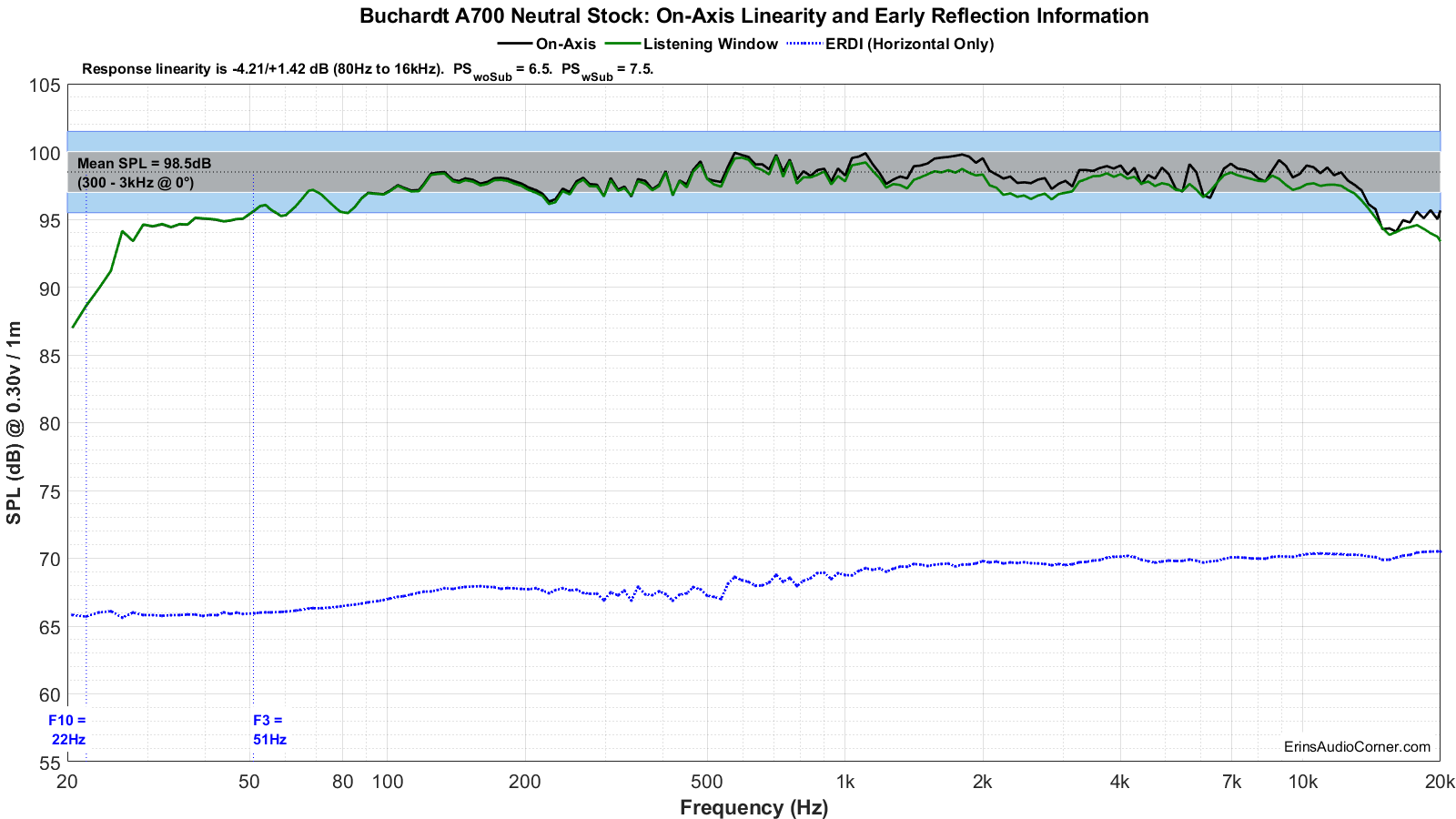
Step Response
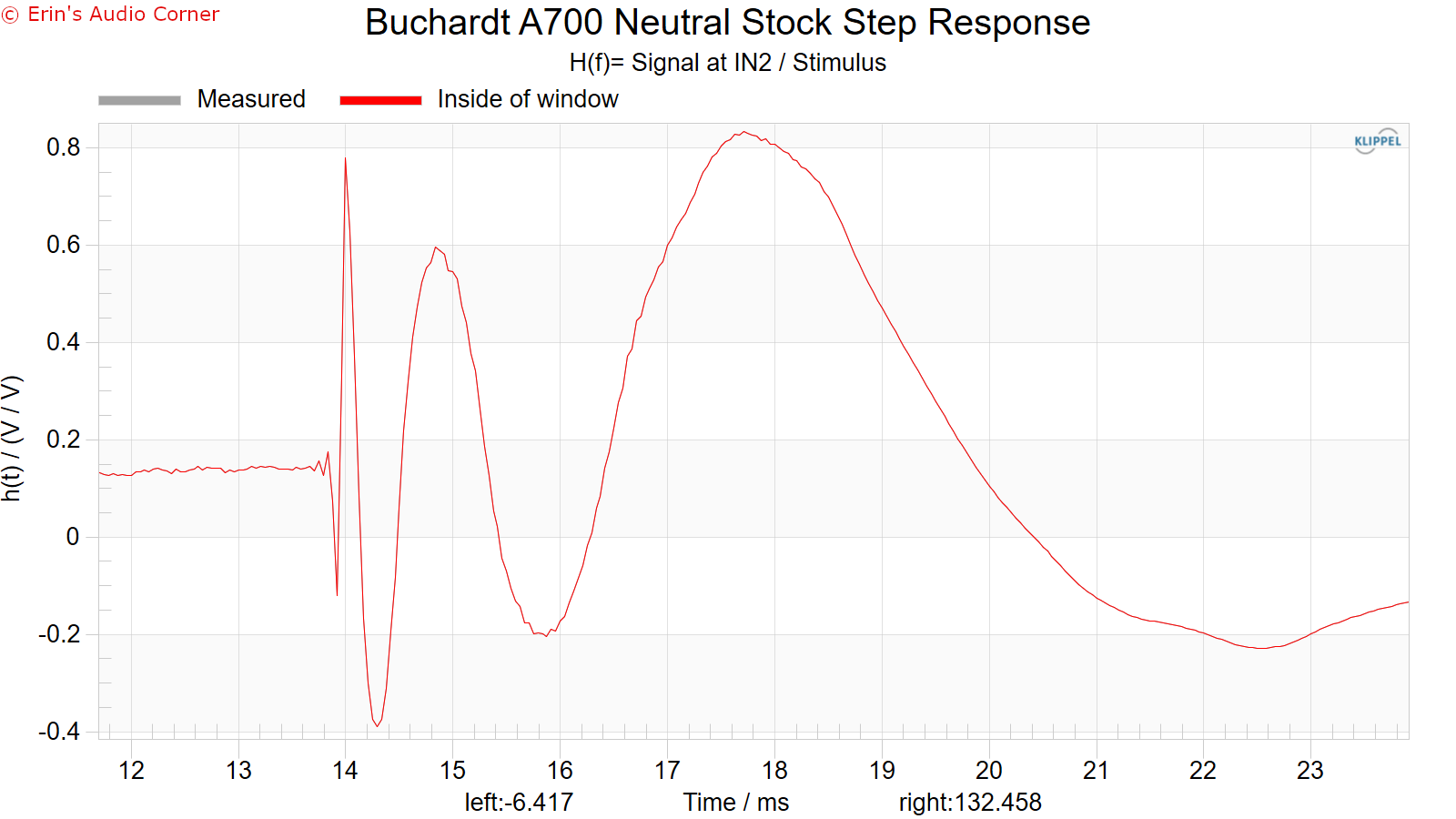
Group Delay

Harmonic Distortion
Harmonic Distortion at 86dB @ 1m:
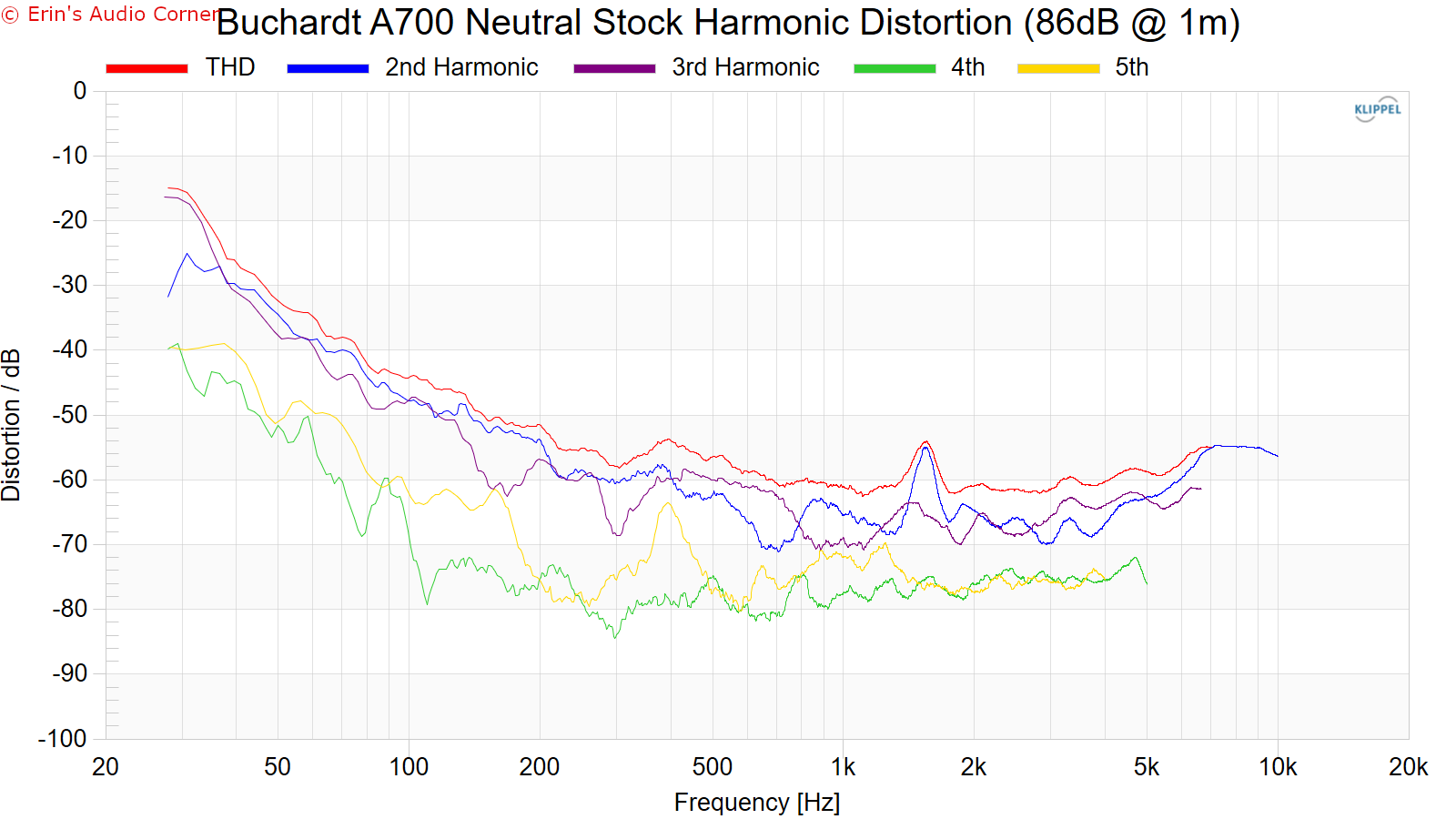
Harmonic Distortion at 96dB @ 1m:
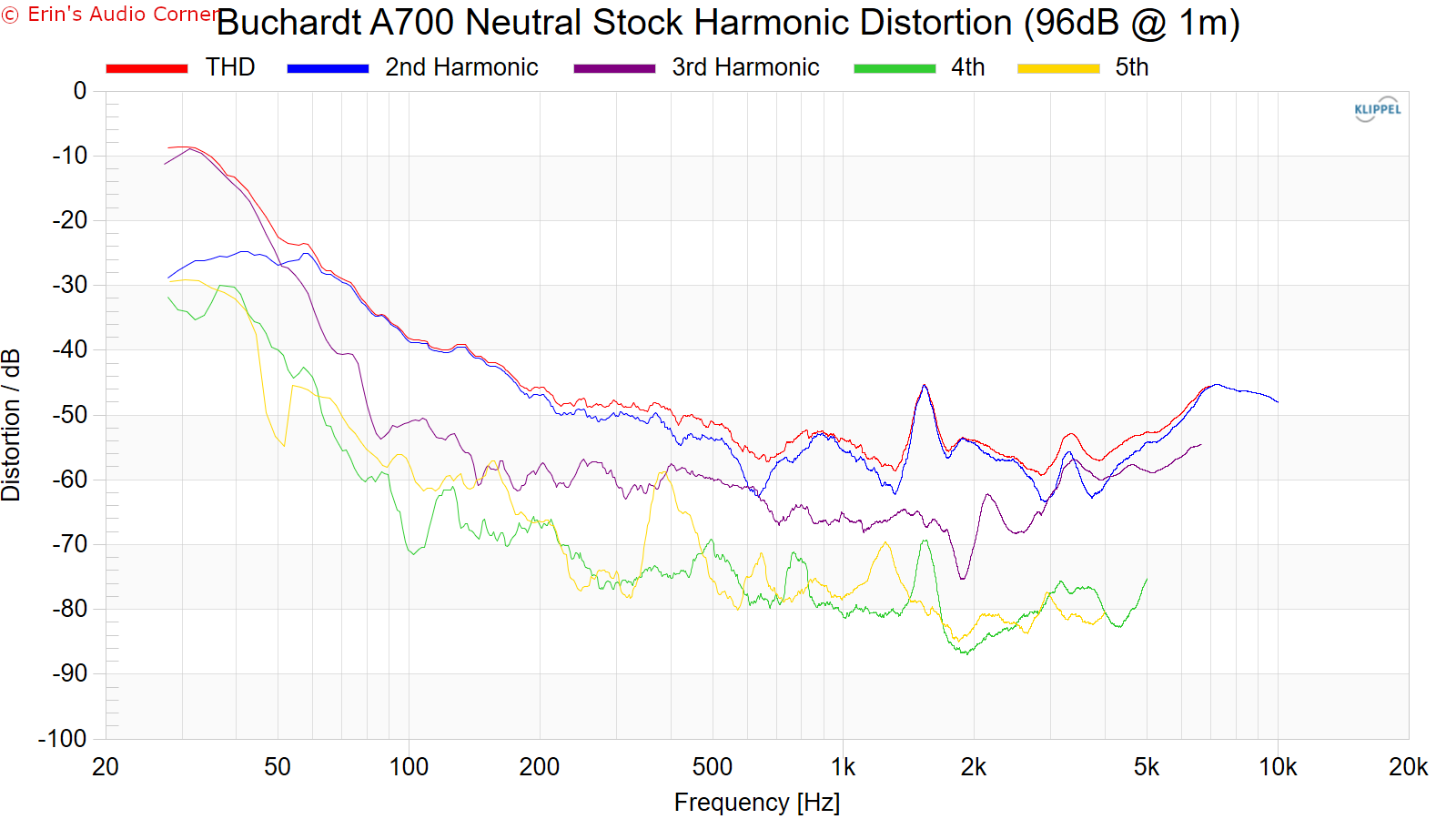
Dynamic Range (Instantaneous Compression Test)
The below graphic indicates just how much SPL is lost (compression) or gained (enhancement; usually due to distortion) when the speaker is played at higher output volumes instantly via a 2.7 second logarithmic sine sweep referenced to 76dB at 1 meter. The signals are played consecutively without any additional stimulus applied. Then normalized against the 76dB result.
The tests are conducted in this fashion:
- 76dB at 1 meter (baseline; black)
- 86dB at 1 meter (red)
- 96dB at 1 meter (blue)
- 102dB at 1 meter (purple)
The purpose of this test is to illustrate how much (if at all) the output changes as a speaker’s components temperature increases (i.e., voice coils, crossover components) instantaneously.
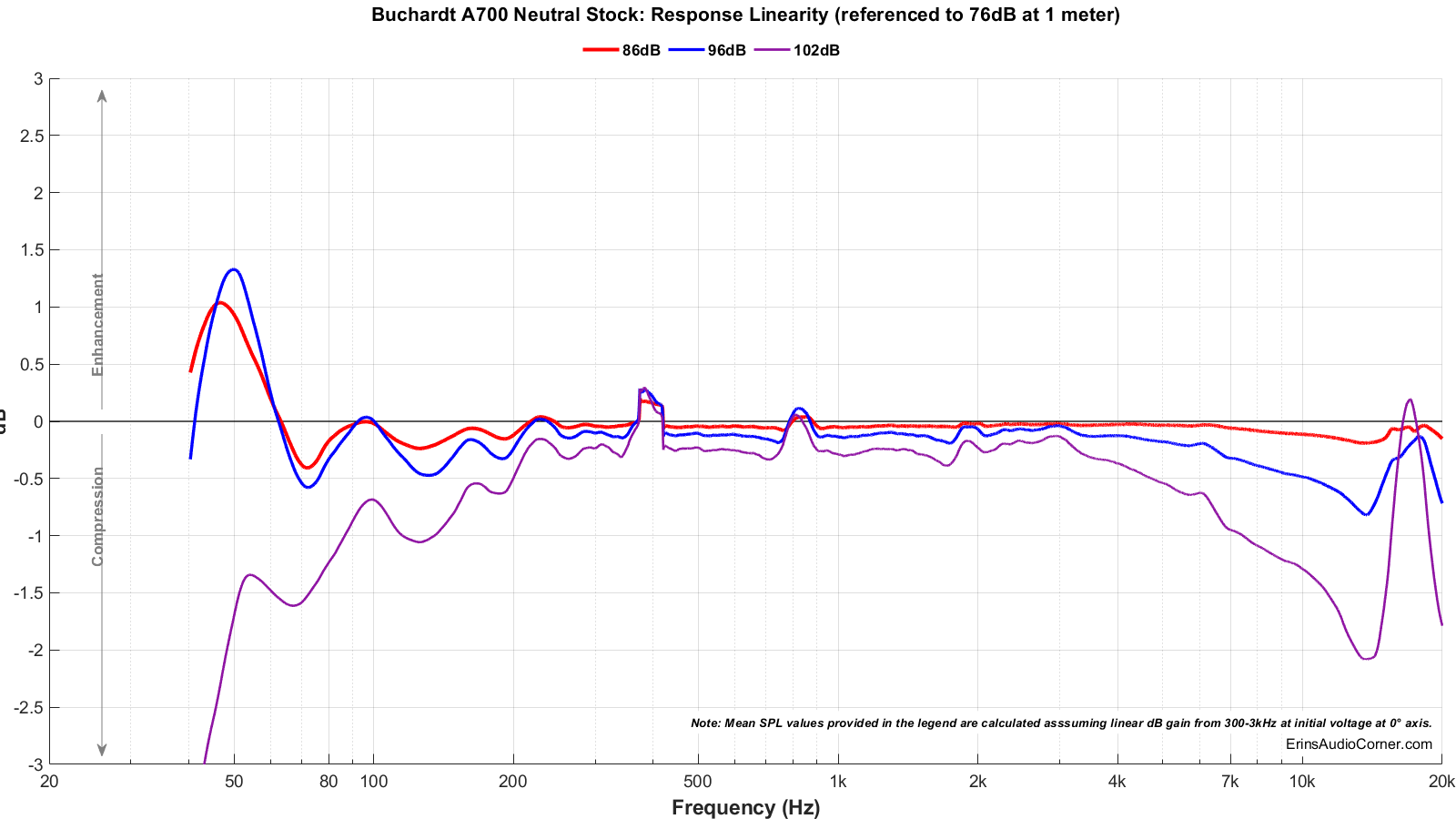
Multitone Distortion
The following tests are conducted at (4) approximate equivalent output volumes: 70/79/87/96dB @ 1 meter. The (4) voltages listed in the legend result in these SPL values.
The test was conducted in (3) manners:
- Full bandwidth (20Hz to 20kHz)
- 80Hz to 20kHz
The reason for the two measurements is to simulate running the speaker full range vs using a high-pass filter at 80Hz. However, note: the 2nd test low frequency limit at 80Hz is a “brick wall” and doesn’t quite emulate a standard filter of 12 or 24dB/octave. But… it’s close enough.
For information on how to read the below data, watch this video:
- Full bandwidth (20Hz to 20kHz)
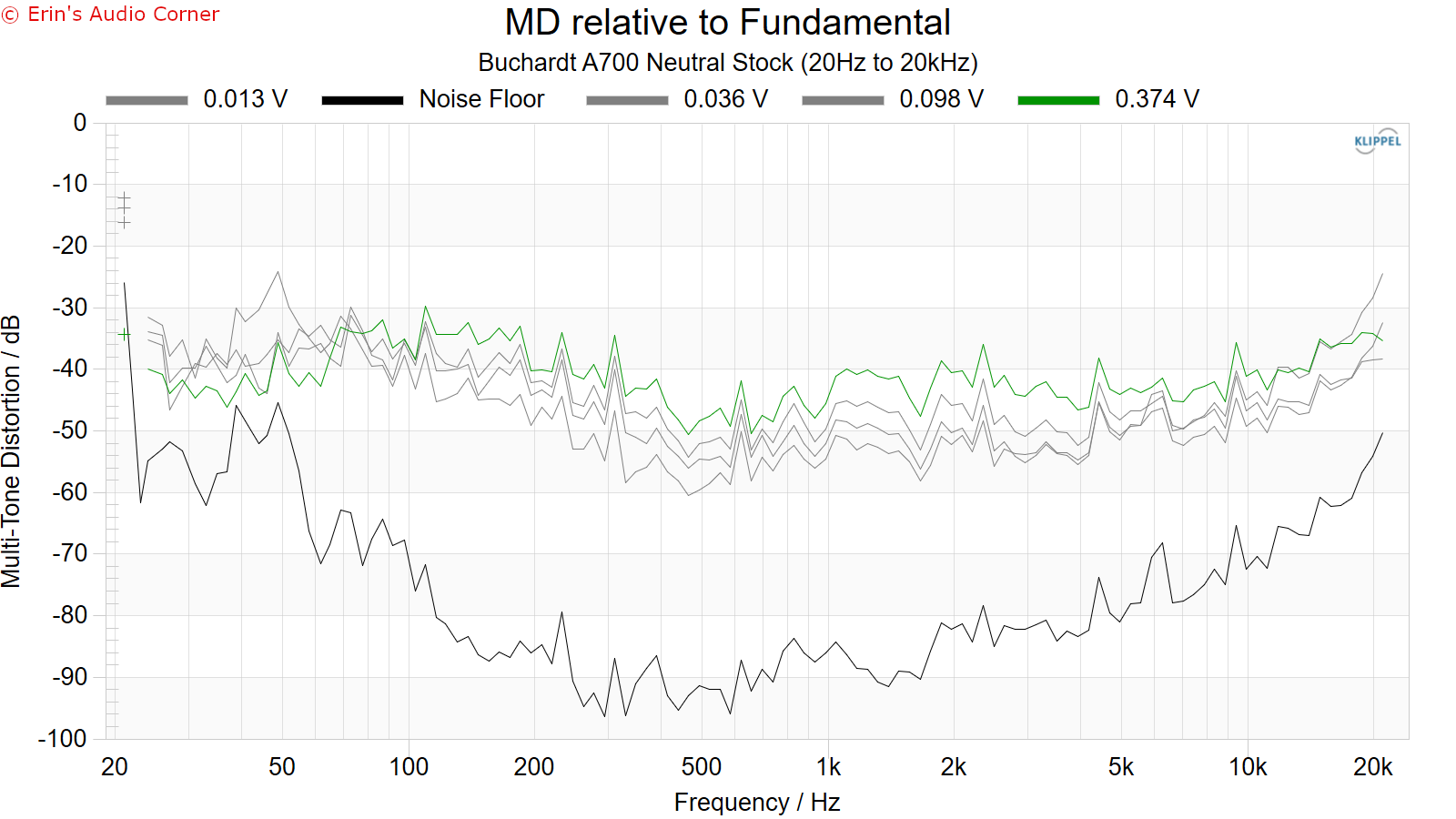
- 80Hz to 20kHz
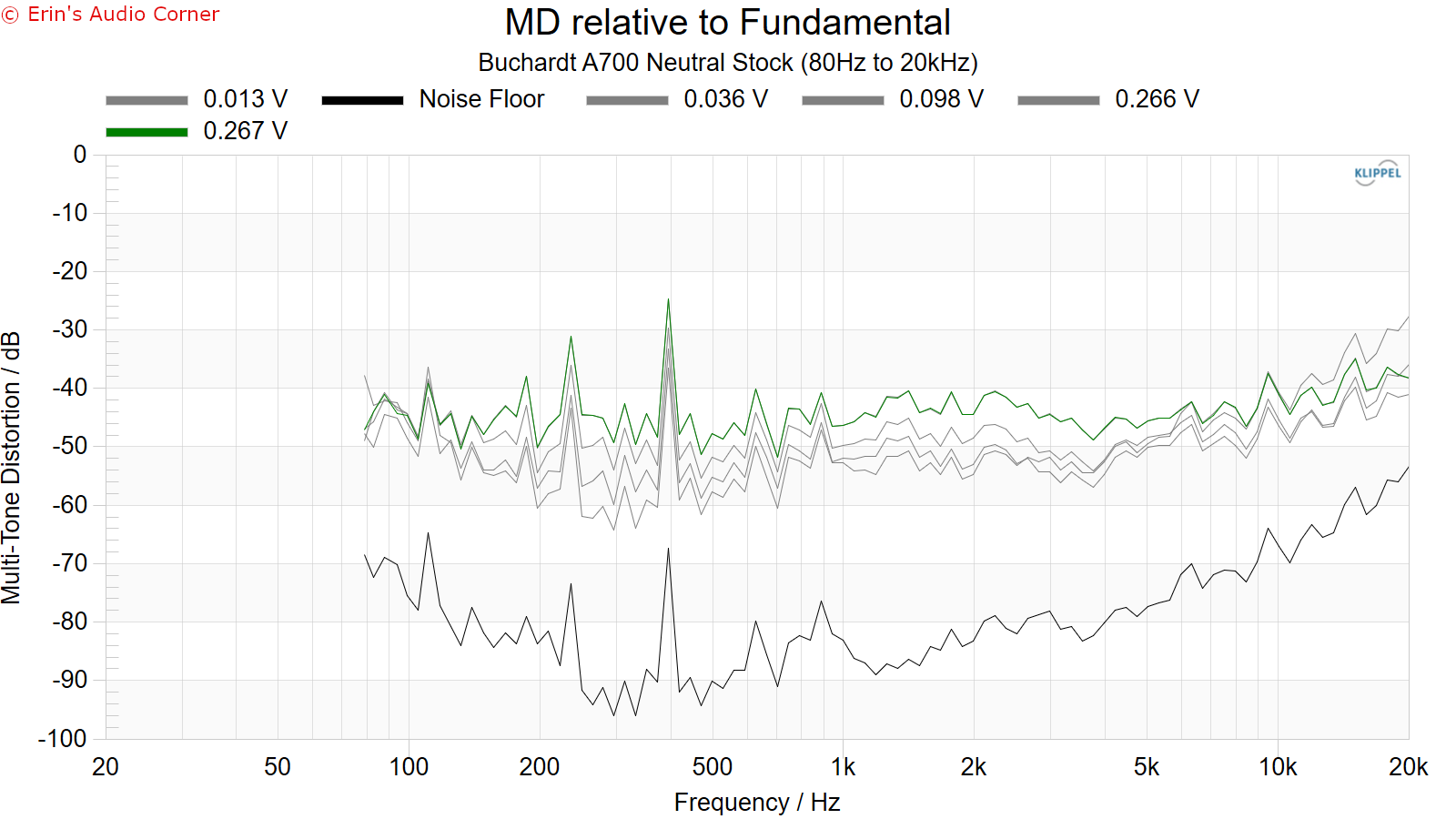
Additional DSP Settings 1: “The Theoretical”

Additional DSP Settings 2: “Cardioid With More Bass (Our Approach)”

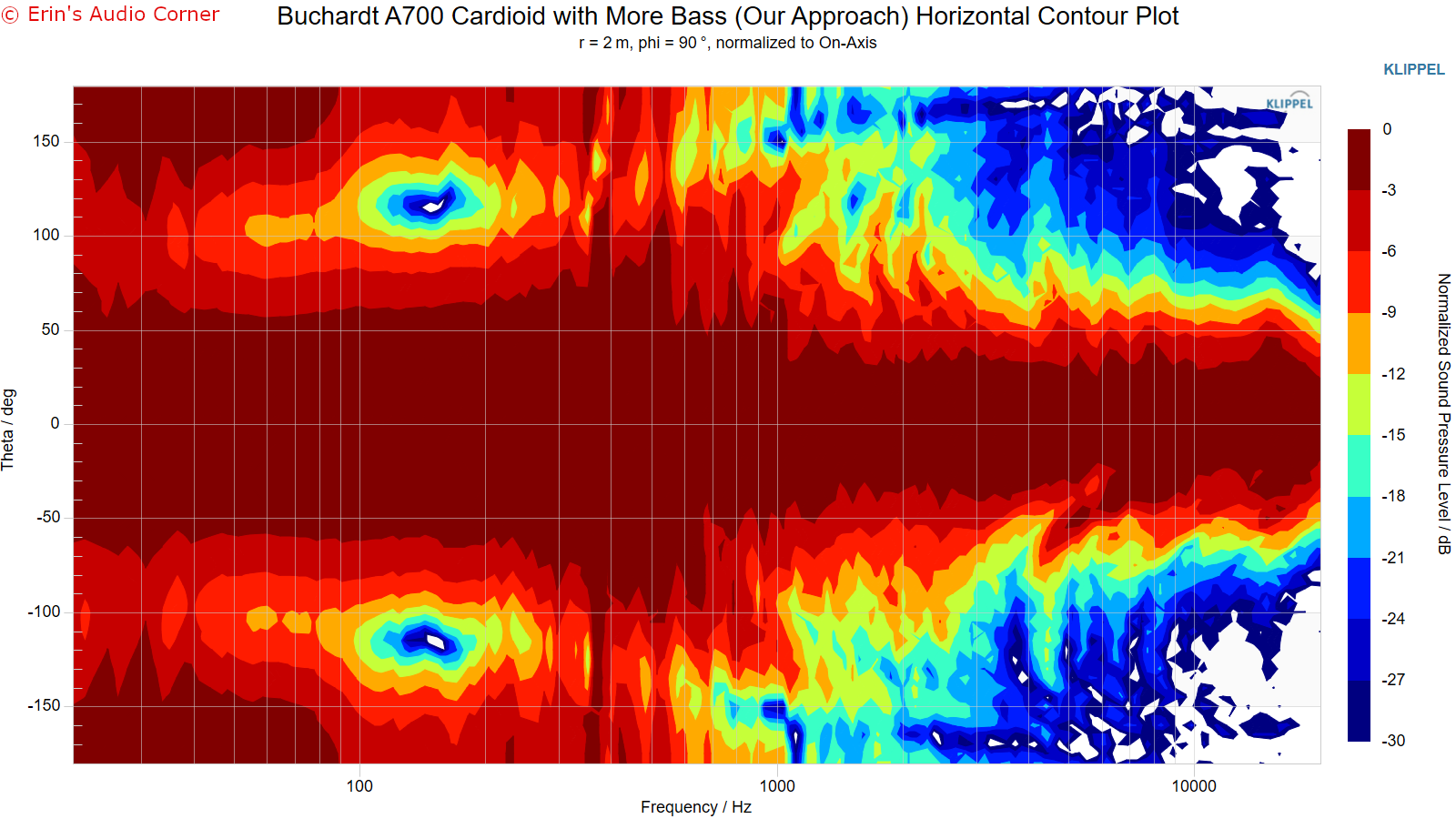

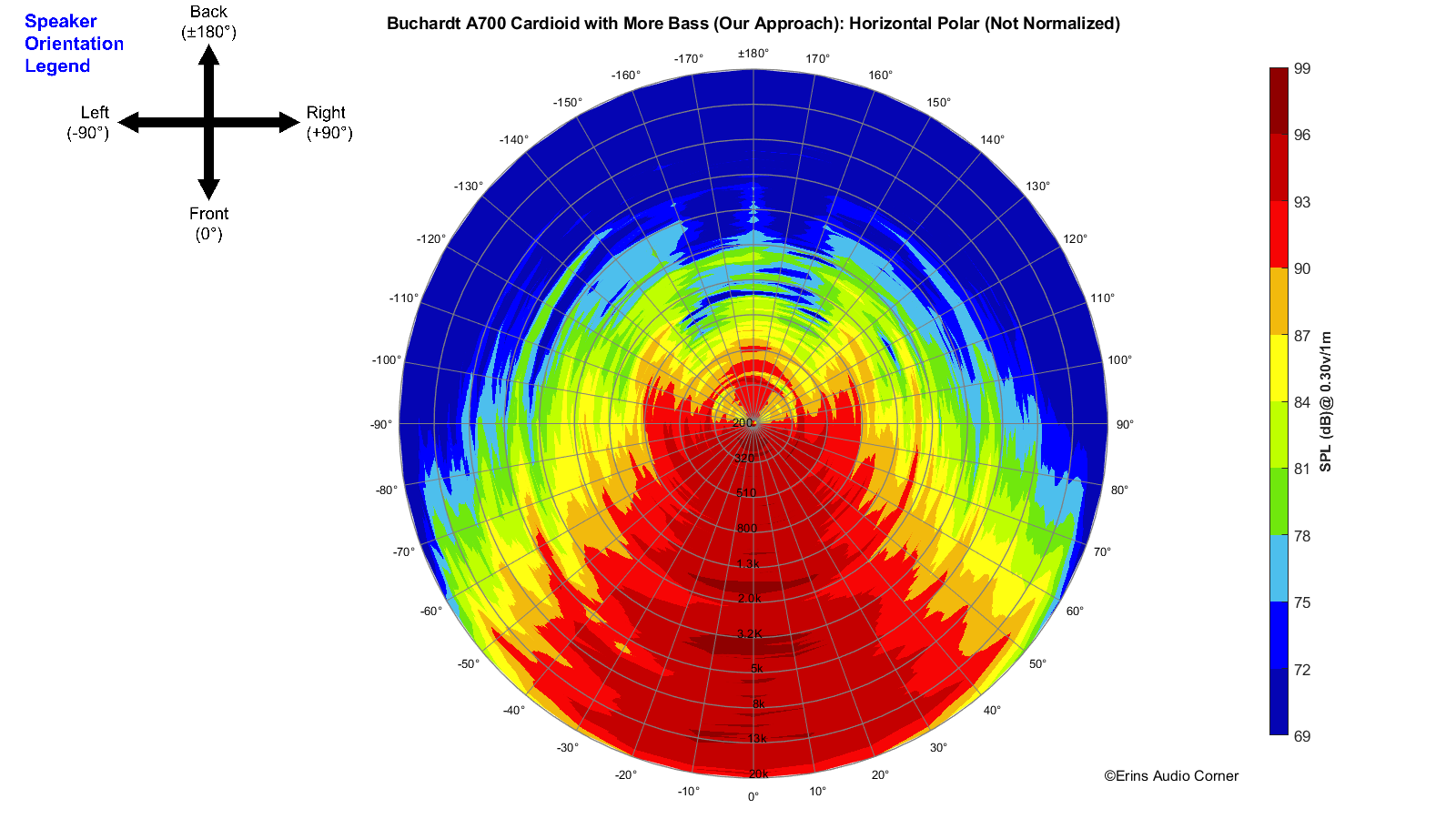

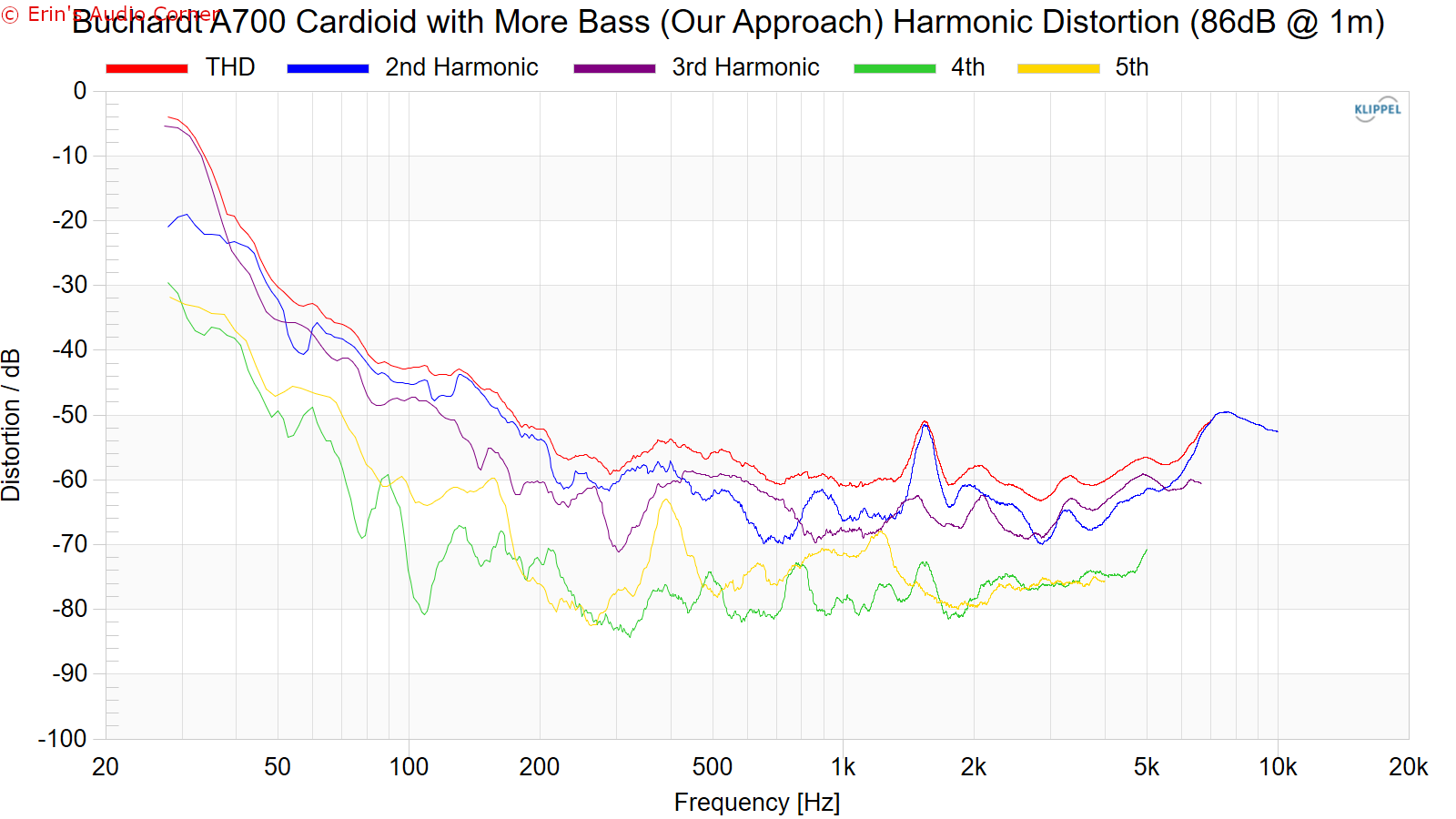
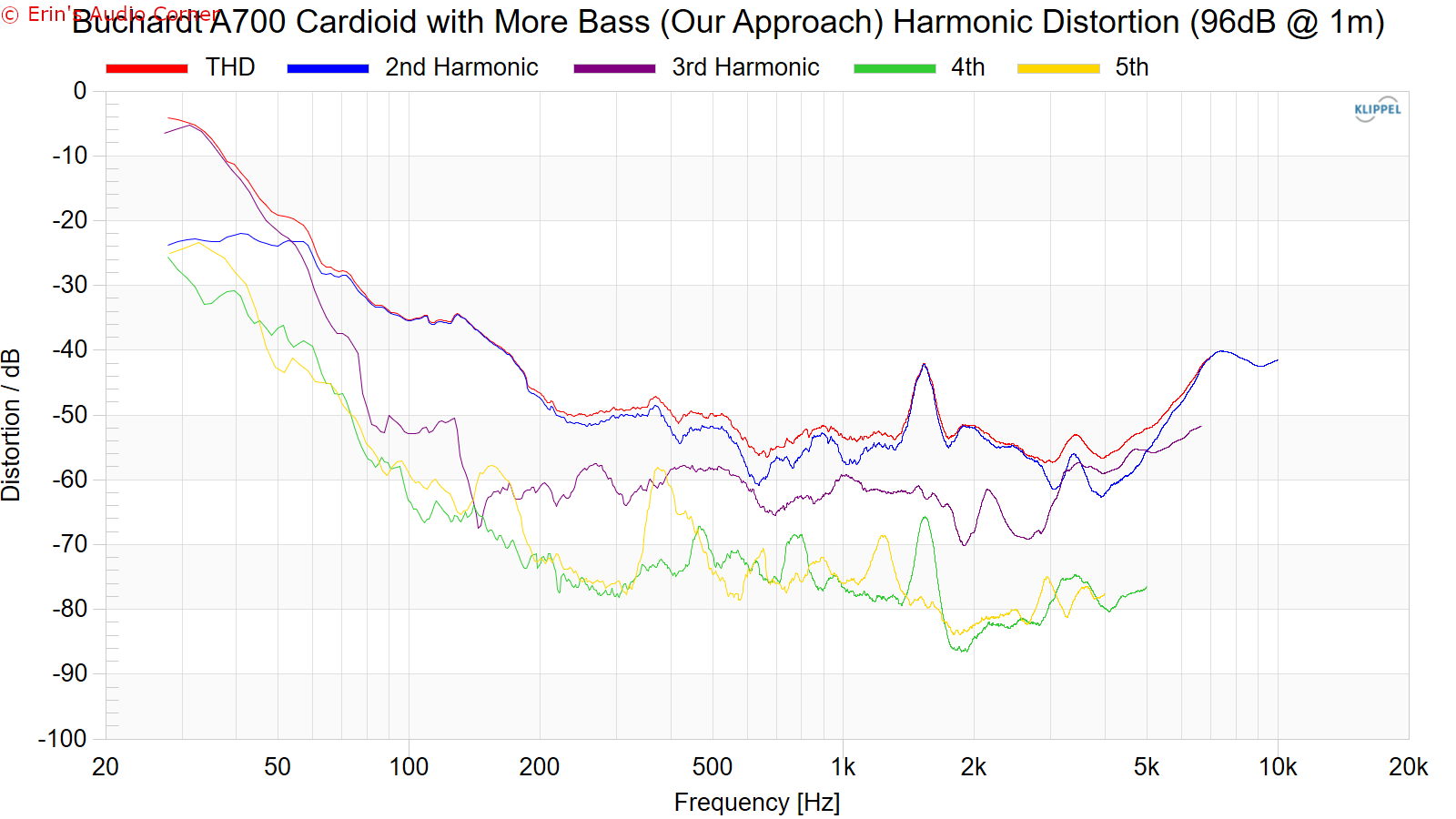
Parting / Random Thoughts
See video linked above for subjective and objective analysis. But just a couple notes:
- I started off listening to the “Neutral (Stock)” setting and the bass in my new (smaller) room was too boomy. This smaller room also means I have to place the speaker closer to the wall behind it; I didn’t have the luxury of moving the speaker one meter from the rear wall and instead could only pull the speaker about 0.30 meters from the rear wall which is not ideal. Therefore, more bass was reinforced from the rear wall and it was just too much and drew attention to itself. This is where the Mastertunings options really shines: I switched over to the Cardioid setting and the response was much more smooth thanks to the rolled off bass (anechoic measurement) and less midbass energy being reinforced by the rear wall which resulted in a smoother in-room bass/midbass response.
- If you plan to purchase these speakers, spend the extra money and purchase the Platin Hub. It’s a no brainer purchase. Spend the extra money. It provides “room eq” and “manual eq”. Both of which are easy to use and very useful.
- Horizontal radiation is a tad on the narrow side for my tastes. I generally prefer a radiation pattern that is ±60° wide where the A700 is closer to about ±50°. However, within this window it remains quite consistent so seating variation within a reasonable listening window should result in pleasurable sound.
- I also found that toeing the speakers out by about 10° helped to decrease the treble in the “Cardioid” mode I listened in while also extending the soundstage width a tad, enough to make it a more enjoyable speaker overall. I would recommend you experiment with toe-out as well because I believe you may also like these speakers at about 5-10° out, depending on how much treble lift you need or prefer in your specific room.
- Remember, these results are with the DSP enabled to provide fullrange reproduction and it does it incredibly well. The distortion and compression (limiting) data indicate this speaker does not take kindly to high output volume but in my listening experience in my home theater at about 3 meters away, I was maxing out at about 105dB (in the midrange/highs). I was pushing this speaker hard without any mechanical noise (which indcates the limiter is protecting the drivers as it should) but, more imporantly, I did not feel the speaker was unable to provide adequate output at this listening distance. I did not notice problematic distortion. So, yes, the data indicates this speaker is only capable of getting so loud but that “so loud” should be plenty for most people. And if you have a subwoofer to pair with these then use a HPF on these to alleviate the distortion/limiting concerns.
- Build quality is quite nice. I like the walnut quite a lot and it should look nice in most living spaces. There is also white and black but I prefer the walnut to those finishes, though it does cost a couple hundred Euro more.
Look, at 6000 Euro, it’s hard for me to classify anything as a “value”. However, the Buchardt checks off many boxes that should satisfy most audiophile types: 1) It sounds very good but more importantly it has multiple tunings that you can use to drill down to the ideal response for you in your room, 2) It is an all-in-one solution that doesn’t require multiple boxes, amps, DACs, etc and 3) It looks nice. If you’re in the market, give it a shot. Buchardt offers a reasonable “Try At Home” policy where you are allowed 45-days to demo the speakers in your own room. You have to cover return shipping costs, however. Find more information here.
Support / Contribute
If you find this review helpful and want to help support the cause that would be AWESOME! There are a few ways you can do so below. Your support helps me pay for new items to test, hardware, miscellaneous items needed for testing, new speakers to review and costs of the site’s server space and bandwidth. Any help is very much appreciated.
Join my Patreon: Become a Patron!
Shopping
If you are shopping at any of the following stores then please consider using my generic affiliate links below to make the purchase through.
Purchases through these links can earn me a small commission - at no additional cost to you - and help me continue to provide the community with free content and reviews. Doesn’t matter if it’s a TV from Crutchfield, budget speakers from Audio Advice or a pair of socks from Amazon, just use the link above before you make your purchase. Thank you!